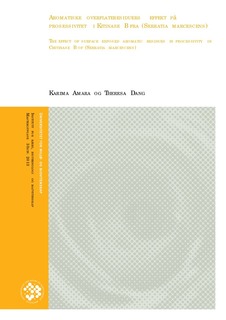Aromatiske overflateresiduers effekt på prosessivitet i kitinase B fra Serratia marcescens
Master thesis

View/
Date
2013-09-09Metadata
Show full item recordCollections
- Master's theses (KBM) [890]
Abstract
Chitin is an insoluble linear polymer of β-1, 4-linked N-acetylglucosamine residues and exhibits structural similarities to cellulose. Chitin is the second most abundant polymer in nature, after cellulose. It is a major structural component of the exoskeleton of insects, crustaceans and cell walls of a variety of fungi. Chitosan, a soluble derivative of chitin, is composed of β-1, 4-linked N-acetylglucosamine and glucosamine units. Chitin and Chitosan are utilized in medicine, agriculture, cosmetics and in the textile industry. A group of enzymes called chitinases degrades chitin and its derivatives.
Chitinase B (ChiB) studied in this project, belongs to family 18 chitinases from the soil bacteria Serratia marcescens. S. marcescens is one of the most efficient bacteria for degradation of chitin and the chitinolytic machinery includes three chitinases: ChiA, ChiB and ChiC.
In ChiB a path of surface exposed aromatic residues, starts at the chitin binding domain (ChBD) and leads into the active site via a support loop. Previously studies have shown that residues near the active site are important for processivity. Based on this, it was interesting to investigate if Y240 and W252 in the support loop and Y481 and W479 in the ChBD had an effect on processivity.
The residues were mutated to alanine and the newly engineered mutants were used in different experiments with chitin and chitosan as substrates. The results from this study showed that aromatic residues in the ChBD have similar properties and are less important for processivity. Y240, the aromatic residue that lies nearest to the active site, showed to be more important for processivity. Thus it can be concluded that the aromatic residues near the catalytic acid are important for processivity, while the role of aromatic residue in the ChBD is to increase the binding between the enzyme and the insoluble polysaccharide chitin.